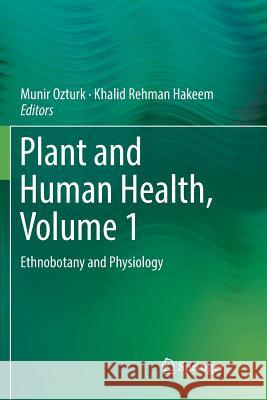Plant and Human Health, Volume 1: Ethnobotany and Physiology » książka



Plant and Human Health, Volume 1: Ethnobotany and Physiology
ISBN-13: 9783030067687 / Angielski / Miękka / 2018 / 805 str.
Plant and Human Health, Volume 1: Ethnobotany and Physiology
ISBN-13: 9783030067687 / Angielski / Miękka / 2018 / 805 str.
(netto: 768,56 VAT: 5%)
Najniższa cena z 30 dni: 771,08
ok. 22 dni roboczych
Dostawa w 2026 r.
Darmowa dostawa!
Foreword by Her Excellency Prof. Dr. Ammenah Gurib Fakim, President, Mauritius,- Turkey’s plant diversity and its opportunities from an ethnobotanical perspective.- Traditional plant based Chinese medicine.- Plants Used in the Traditional Medicine in East Africa.- Herbal Medicines from Palestine and Jordan.- Herbals from Hindukush.- Plants used in the traditional medicine in Sindh-Pakistan.- Medicinal and Aromatic Plants from Uzbekistan.- Herbal Medicine in Pakistan, Past, Present and Future.- Medicinal and Aromatic Plants of Iğdır (Turkey), Nahçivan (Azerbaijan) and Tebriz (Iran).- Medicinal Aromatic Halophytes of Iran.- Traditional Medicine in Malang and Environs-Indonesia.- Agro-physiological aspects for domestication of Alliums as a crop for medicinal purposes.- Evaluation of poisonous plants from the plant diversity in Upper Mesopotamia.- Herbal folk medicine used in the treatment of hypertension and diabetes in Southeast Anatolian Region of Turkey.- Medicinal & Aromatic Plants of Sri Lanka.- Cosmetic uses of native plants in Turkey: Reflections on public health and economy.- Traditional Medicine in Azad Kashmir-Pakistan.- Herbals Used in the Folk Medicine of Kirghizistan.- Traditional Medicine Research and Development in Nigeria.- Medicinal Aspects of Andrographis paniculata.- Traditional and Modern Applications: A Case Study from South Indian Trees.- Indigenous Knowledge Systems and Product Development in South Africa.- Herbal Medicinal Plants and Traditional Herb Remedies.- Medicinal Plants of Kashmir Himalaya and Unani Medicine.- Bruneian Knowledge and Practice in Traditional Medicines.- Herbal Remedies by Medicinal Resources in Bhutan.- Traditional Medicine and Medicinal Plants in the Lao PDR.- Traditional Use and Research on Herbal in Mauritius.- Traditional Medical Science in Mongolia.- Status of Medicinal Plants and Prospects of their Cultivation.- IPR Protection and MAPS.
Dr. Khalid Rehman Hakeem (PhD) is an Associate Professor at King Abdulaziz University, Jeddah, Saudi Arabia. He has completed his Ph.D. (Botany) from Jamia Hamdard, New Delhi, India in 2011. Dr. Hakeem has worked as Post Doctorate Fellow in 2012 and Fellow Researcher (Associate Prof.) from 2013-2016 at Universiti Putra Malaysia, Selangor, Malaysia. His speciality is in Plant Eco-Physiology, Molecular biology, Plant-Microbe-soil interactions, Medicinal plant research and Environmental Sciences and so far has edited and authored more than 25 books with Springer International, Academic Press (Elsevier) etc. He has also to his credit more than 110 research publications in peer reviewed international journals, including 40 book chapters in edited volumes with international publishers. Dr Hakeem is the recipient of many national and international awards and fellowships.
Early anthropological evidence for plant use as medicine is 60,000 years old as reported from the Neanderthal grave in Iraq. The importance of plants as medicine is further supported by archeological evidence from Asia and the Middle East. Today, around 1.4 billion people in South Asia alone have no access to modern health care, and rely instead on traditional medicine to alleviate various symptoms. On a global basis, approximately 50 to 80 thousand plant species are used either natively or as pharmaceutical derivatives for life-threatening conditions that include diabetes, hypertension and cancers. As the demand for plant-based medicine rises, there is an unmet need to investigate the quality, safety and efficacy of these herbals by the “scientific methods”. Current research on drug discovery from medicinal plants involves a multifaceted approach combining botanical, phytochemical, analytical, and molecular techniques. For instance, high throughput robotic screens have been developed by industry; it is now possible to carry out 50,000 tests per day in the search for compounds, which act on a key enzyme or a subset of receptors. This and other bioassays thus offer hope that one may eventually identify compounds for treating a variety of diseases or conditions. However, drug development from natural products is not without its problems. Frequent challenges encountered include the procurement of raw materials, the selection and implementation of appropriate high-throughput bioassays, and the scaling-up of preparative procedures.
Research scientists should therefore arm themselves with the right tools and knowledge in order to harness the vast potentials of plant-based therapeutics. The main objective of Plant and Human Health is to serve as a comprehensive guide for this endeavor. Volume 1 highlights how humans from specific areas or cultures use indigenous plants. Despite technological developments, herbal drugs still occupy a preferential place in a majority of the population in the third world and have slowly taken roots as alternative medicine in the West. The integration of modern science with traditional uses of herbal drugs is important for our understanding of this ethnobotanical relationship. Volume 2 deals with the phytochemical and molecular characterization of herbal medicine. Specifically, it focuses on the secondary metabolic compounds, which afford protection against diseases. Lastly, Volume 3 discusses the physiological mechanisms by which the active ingredients of medicinal plants serve to improve human health. Together this three-volume collection intends to bridge the gap for herbalists, traditional and modern medical practitioners, and students and researchers in botany and horticulture.1997-2025 DolnySlask.com Agencja Internetowa
KrainaKsiazek.PL - Księgarnia Internetowa









